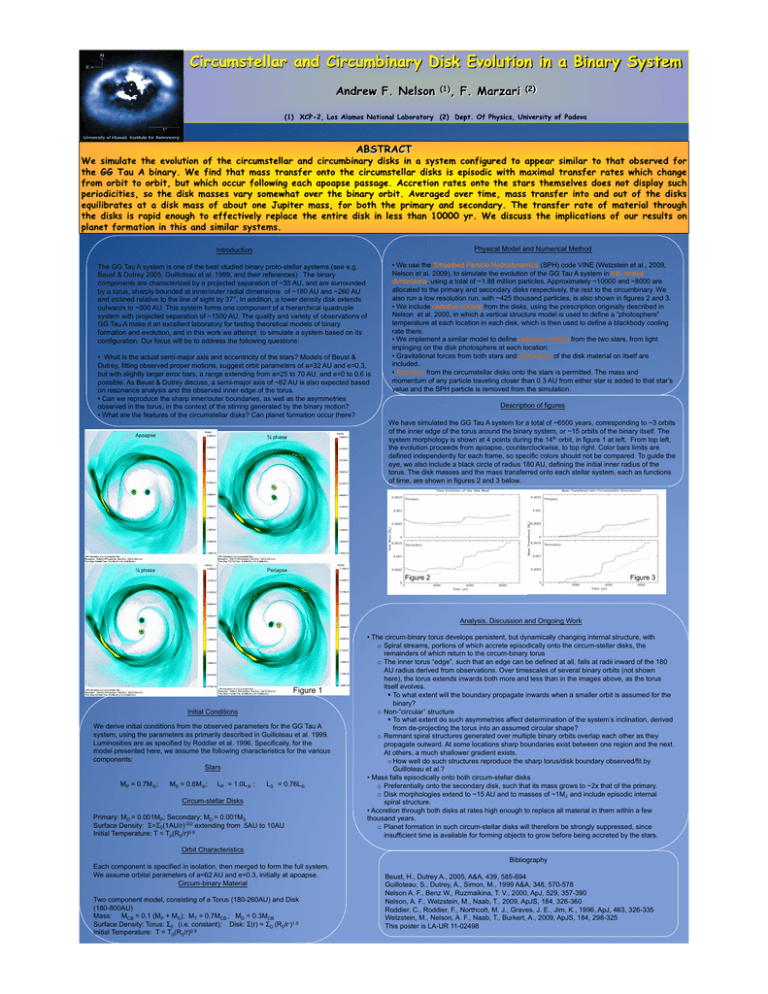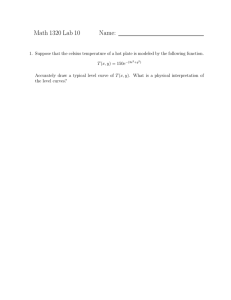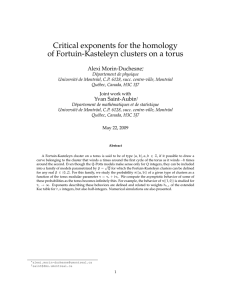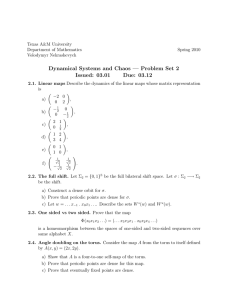Figure 1
advertisement

Introduction Physical Model and Numerical Method The GG Tau A system is one of the best studied binary proto-stellar systems (see e.g. Beust & Dutrey 2005, Guilloteau et al. 1999, and their references) . The binary components are characterized by a projected separation of ~35 AU, and are surrounded by a torus, sharply bounded at inner/outer radial dimensions of ~180 AU and ~260 AU and inclined relative to the line of sight by 37°. In addition, a lower density disk extends outwards to ~800 AU. This system forms one component of a hierarchical quadruple system with projected separation of ~1500 AU. The quality and variety of observations of GG Tau A make it an excellent laboratory for testing theoretical models of binary formation and evolution, and in this work we attempt to simulate a system based on its configuration. Our focus will be to address the following questions: • We use the Smoothed Particle Hydrodynamics (SPH) code VINE (Wetzstein et al., 2009, Nelson et al. 2009), to simulate the evolution of the GG Tau A system in two spatial dimensions, using a total of ~1.88 million particles. Approximately ~10000 and ~8000 are allocated to the primary and secondary disks respectively, the rest to the circumbinary. We also run a low resolution run, with ~425 thousand particles, is also shown in figures 2 and 3. • We include radiative cooling from the disks, using the prescription originally described in Nelson et al. 2000, in which a vertical structure model is used to define a “photosphere” temperature at each location in each disk, which is then used to define a blackbody cooling rate there. • We implement a similar model to define radiative heating from the two stars, from light impinging on the disk photosphere at each location. • Gravitational forces from both stars and self gravity of the disk material on itself are included. • Accretion from the circumstellar disks onto the stars is permitted. The mass and momentum of any particle traveling closer than 0.3 AU from either star is added to that star’s value and the SPH particle is removed from the simulation. • What is the actual semi-major axis and eccentricity of the stars? Models of Beust & Dutrey, fitting observed proper motions, suggest orbit parameters of a=32 AU and e=0.3, but with slightly larger error bars, a range extending from a=25 to 70 AU, and e=0 to 0.6 is possible. As Beust & Dutrey discuss, a semi-major axis of ~62 AU is also expected based on resonance analysis and the observed inner edge of the torus. • Can we reproduce the sharp inner/outer boundaries, as well as the asymmetries observed in the torus, in the context of the stirring generated by the binary motion? • What are the features of the circumstellar disks? Can planet formation occur there? Apoapse ¾ phase ¼ phase Periapse Description of figures We have simulated the GG Tau A system for a total of ~6500 years, corresponding to ~3 orbits of the inner edge of the torus around the binary system, or ~15 orbits of the binary itself. The system morphology is shown at 4 points during the 14th orbit, in figure 1 at left. From top left, the evolution proceeds from apoapse, counterclockwise, to top right. Color bars limits are defined independently for each frame, so specific colors should not be compared. To guide the eye, we also include a black circle of radius 180 AU, defining the initial inner radius of the torus. The disk masses and the mass transferred onto each stellar system, each as functions of time, are shown in figures 2 and 3 below. Figure 2 Figure 3 Analysis, Discussion and Ongoing Work Figure 1 Initial Conditions We derive initial conditions from the observed parameters for the GG Tau A system, using the parameters as primarily described in Guilloteau et al. 1999. Luminosities are as specified by Roddier et al. 1996. Specifically, for the model presented here, we assume the following characteristics for the various components: Stars MP = 0.7M; MS = 0.6M; LP = 1.0L ; LS = 0.76L" Circum-stellar Disks Primary: MD = 0.001MP; Secondary: MD = 0.001MS Surface Density: Σ=Σ0(1AU/r)-3/2 extending from .5AU to 10AU Initial Temperature: T = T0(R0/r)0.9 • The circum-binary torus develops persistent, but dynamically changing internal structure, with o Spiral streams, portions of which accrete episodically onto the circum-stellar disks, the remainders of which return to the circum-binary torus o The inner torus “edge”, such that an edge can be defined at all, falls at radii inward of the 180 AU radius derived from observations. Over timescales of several binary orbits (not shown here), the torus extends inwards both more and less than in the images above, as the torus itself evolves. To what extent will the boundary propagate inwards when a smaller orbit is assumed for the binary? o Non-”circular” structure To what extent do such asymmetries affect determination of the system’s inclination, derived from de-projecting the torus into an assumed circular shape? o Remnant spiral structures generated over multiple binary orbits overlap each other as they propagate outward. At some locations sharp boundaries exist between one region and the next. At others, a much shallower gradient exists. o How well do such structures reproduce the sharp torus/disk boundary observed/fit by Guilloteau et al.? • Mass falls episodically onto both circum-stellar disks o Preferentially onto the secondary disk, such that its mass grows to ~2x that of the primary. o Disk morphologies extend to ~15 AU and to masses of ~1MJ and include episodic internal spiral structure. • Accretion through both disks at rates high enough to replace all material in them within a few thousand years. o Planet formation in such circum-stellar disks will therefore be strongly suppressed, since insufficient time is available for forming objects to grow before being accreted by the stars. Orbit Characteristics Each component is specified in isolation, then merged to form the full system. We assume orbital parameters of a=62 AU and e=0.3, initially at apoapse. Circum-binary Material Two component model, consisting of a Torus (180-260AU) and Disk (180-800AU) Mass: MCB = 0.1 (MP + MS); MT = 0.7MCB ; MD = 0.3MCB Surface Density: Torus: Σ0 (i.e. constant); Disk: Σ(r) = ΣD (R0/r-)1.5 Initial Temperature: T = T0(R0/r)0.9 Bibliography Beust, H., Dutrey A., 2005, A&A, 439, 585-694 Guilloteau, S., Dutrey, A., Simon, M., 1999 A&A, 348, 570-578 Nelson A. F., Benz W., Ruzmaikina, T. V., 2000, ApJ, 529, 357-390 Nelson, A. F., Wetzstein, M., Naab, T., 2009, ApJS, 184, 326-360 Roddier, C., Roddier, F., Northcott, M. J., Graves, J. E., Jim, K., 1996, ApJ, 463, 326-335 Wetzstein, M., Nelson, A. F., Naab, T., Burkert, A., 2009, ApJS, 184, 298-325 This poster is LA-UR 11-02498



